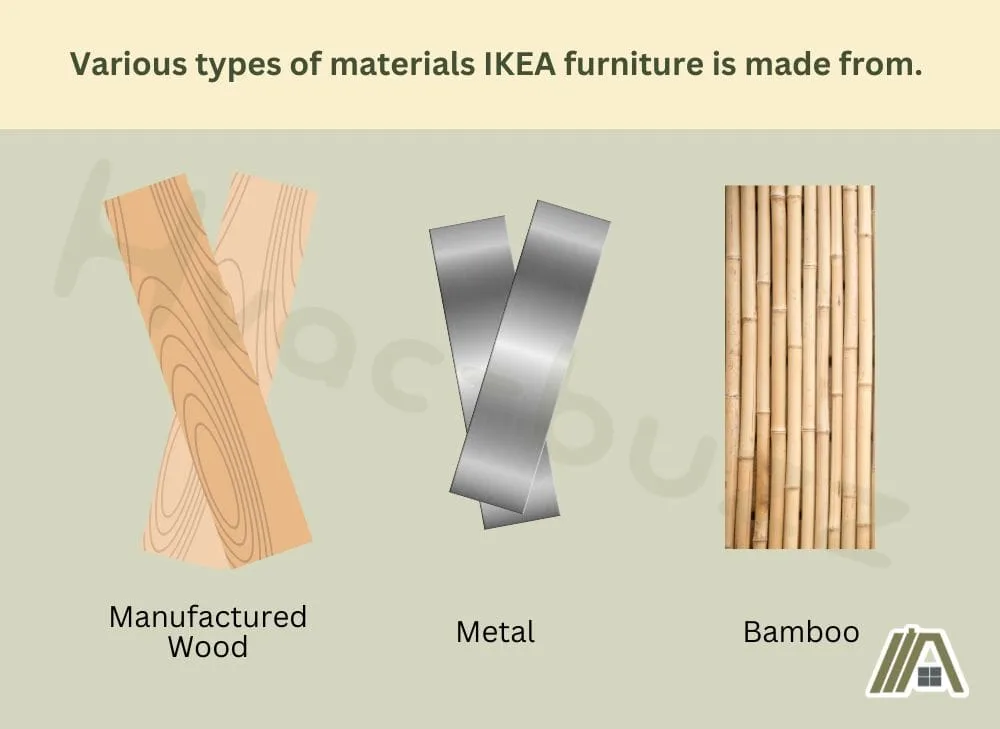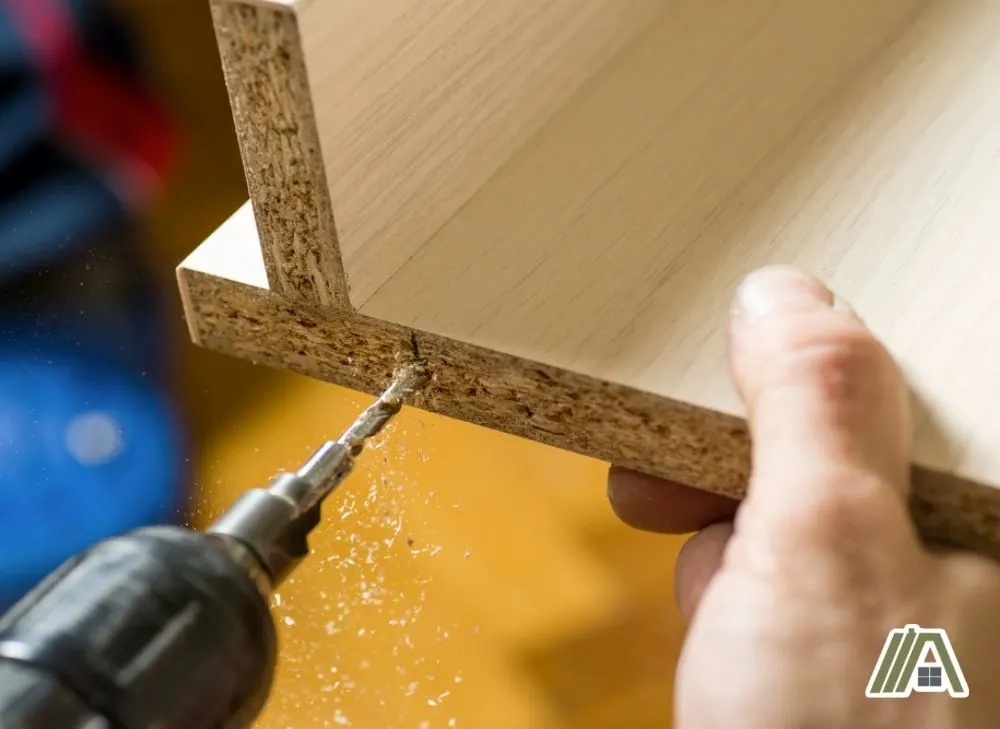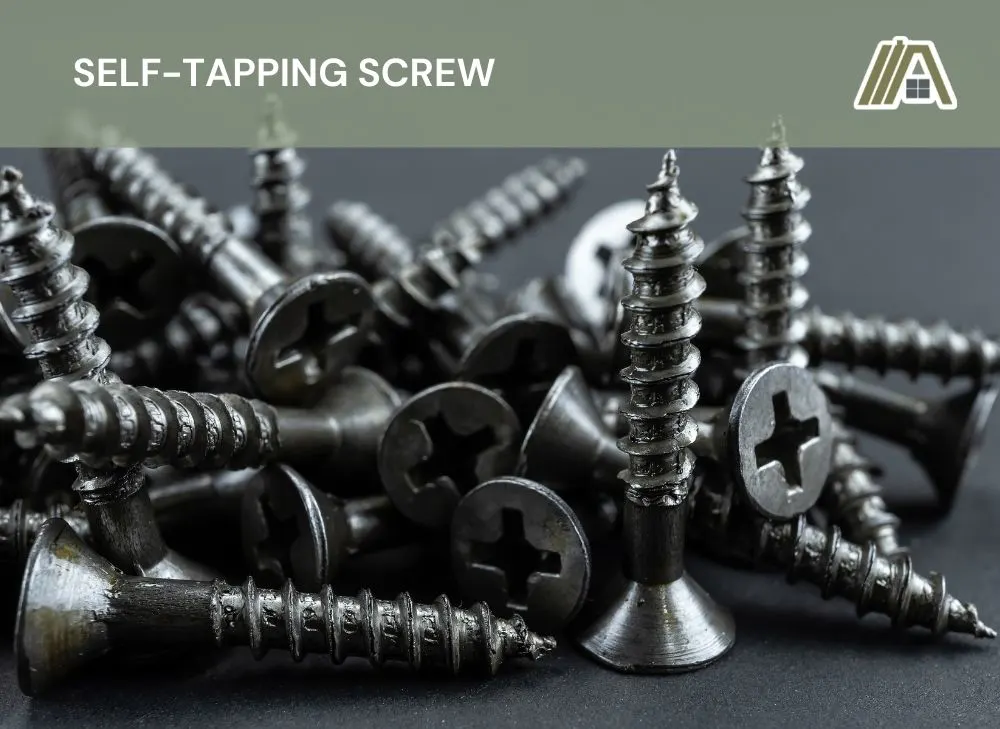I’m not sure where and when I learned it, but it seems like I’ve always been aware of how delicate particleboard is when it comes to drilling and screws. It also means that, at first, I was wary of trying to make IKEA furniture assembly easier and more secure by using a drill and screws.
Just because it is easier to damage the manufactured wood doesn’t mean you can’t get out your drill and install the screw (or extras) for assembly and reinforcement. You just need to know a few things about how best to do it to avoid the possible pitfalls.

IKEA furniture is commonly made from particleboard, which is a manufactured wood prone to breaking when it comes to screws. Well-positioned pilot holes help prevent the wood from cracking and splitting, and using the correct screws and carefully tightening them is important.
What is IKEA Furniture Made Of?
IKEA furniture is made from various types of materials, including wood and manufactured wood, metal, plastic, bamboo, and other natural materials.
You will find a mixture of hard and soft solid woods and wood veneers alongside the particleboard and fiberboards in IKEA furniture.

The reason that IKEA furniture is so affordable is because much of it is made from particleboard. This is a combination of wood shaving, chips, and sawdust that is glued into a board.
This is a low-density material mainly made of smaller particles, which means it is not the most robust material out there, but it is cheaper.
The quality and longevity of IKEA furniture depend on the price you are willing to pay, but the company strives for sustainability in the materials they use, the practices they employ, and the products they produce.
Can You Drill Into IKEA Furniture?
One thing I have found with the flatpack furniture from IKEA is that the pre-drilled holes are not always as helpful as you would like.
I am no stranger to having to pull out a drill to fix the too-small or too-shallow holes that are meant to make assembly easier.
You may also need to drill a new hole if the previous one was damaged during assembly, disassembly, or reassembly.
Yes, you can drill into IKEA’s furniture, but you need to remember how you do it and what materials and tools you are working with will impact your success.
What Could Go Wrong
When drilling into a piece of pre-cut furniture, you need to consider what the item is made of, both inside and out.
For example, IKEA often sells particleboard furniture with a plastic covering or wooden veneer. I do not recommend drilling through this unless you are willing to have it crack and peel off.
- If you place pilot holes too close to the edge of the board, chipping can occur around the spot, or sections of the board can snap off when you insert the screws. This is particularly a problem when you have to drill into the side edge of the particleboard.
- You can strip the screw hole. If you mismatch the drill bit to the screws, you can leave too little material for the screw to grip into. In this case, you can either get wider screws or you can repair the hole.
- You can add wood glue into the hole or a wooden dowel to refill the space and give the screw something to hold onto. You can still use glue to secure the dowel in the hole.
How to Do It Right
Take your time while drilling. There is no need to rush, and it is better to ensure you have the right bit and are drilling well.

Drill Carefully
You need to drill your pilot holes (pre-drilled holes that make putting the screws in easier and less damaging to the item) straight and the correct size. Then, start slow and increase the speed a little if you are more confident.
To keep them from stripping the hole with the drill, which will prevent the screw from getting a good grip, you should drill slowly to not overdo it.
You also need to think about where you are drilling. If you are adding extra holes into the furniture, you need to consider the most secure placement and ensure they are not too close to the edge of the board.
Size of the Hole
You need to make the pilot holes in the wood to prevent splitting, but you also need to make the drilled hole smaller than the screw. If you drill the hole the same size as the screw, the threading won’t be able to bite into and grip the wood properly.
The size of the pilot hole depends on the minor diameter of the screw. Since the threads on a screw are not uniform, you get a major and minor diameter going from smaller to larger to create a more secure fit. The minor diameter is the size of the thread near the tip of the screw.
This all sounds very complicated, so an easier way to estimate is by putting the tip of the screw against the tip of the drill bit. If the shank of the screw (the part without threads) is a bit bigger than the drill bit, the screw should grip nicely going in.
Depth
Make sure that your pilot holes are long enough to do the job. If you put a long screw in but only pre-drill a shallow hole, you can still have problems with the particleboard breaking.
You also need to drill deep enough to properly countersink (if necessary) the screw you will insert. Otherwise, you might have the screw’s head sticking out, which can hurt you or catch your clothing.
Best Drill Bits to Use
The best drill bit to use depends on what you are trying to get through. You commonly get drill bits for metal, wood, concrete/stone, and plastic. These should be used accordingly to produce the best results.
For particle board, you will need a wood drill bit. This has a little point at the tip to help you position the drill more accurately. This bit is also designed with a slight taper, which helps prevent ripping and breaking while drilling into wood.
Once you have identified the drill bits for wood, you need to select the size of the bit, which, as mentioned previously, needs to be a little narrower than the shank screw.
Can You Put Screws Into IKEA Furniture?
You can put screws in the variety of wooden furniture that IKEA offers, including particleboard items. However, as with drilling into wood (especially particleboard), you need to take some care with how you do it.
It is not as perilous as you think to put screws into particleboard as long as you prepare properly.
What Could Go Wrong
Most of the potential problems associated with putting screws in wood can be circumvented by pre-drilling. However, I will still mention a few issues that can occur:
- A certain amount of force is required to get screws into wood (less with pilot holes). However, when applying this force, you can end up stripping the head of the screw or breaking the screw.
- With the pressure from the force of the screw going in, you can break the wood. Wood can split around the force of the screw. You also risk chipping the wood around the screw, which is unsightly for your furniture and can compromise the secureness of the screw in the board.
- If you make the pilot hole too close to the edge, you can chip the wood and compromise the anchor point. You risk a screw snapping free with a chunk of wood because the wood wasn’t strong enough to withstand the pressure at that point.
How to Do It Right
You need to be gentle and steady when using screws on particleboard.
Pilot Holes
Make use of pre-drilled holes that are slightly smaller than the screws. These reduce the pressure on the wood as the screw goes in, preventing the particleboard from splitting and chipping. It also helps prevent the screws from snapping or getting stripped.
Use the Right Screws
Using the correct screws for particleboard is a good way to help prevent problems like stripped screw holes and screws that don’t hold firm in the board. Chipboard and self-tapping screws are the best fit for particleboard.
Reinforce the Holes
You can also use a bit of wood glue to create a better grip for the screw in the hole.
Any wood glue will do for this, like Titebond III (amazon link) or Elmer’s Carpenter Glue (amazon link). However, you need to make sure you are covering the area well. Spread the glue (a toothpick or your finger will work well) through the pilot hole and let it dry.
The adhesive is stronger than the particle board and creates a better surface for the screws to attach to.
Tighten Slowly
When you are actually putting the screw in, you need to tighten it slowly (even with the drill), keeping constant and even pressure. Yes, you need some pressure to prevent stripping the screw and to make sure it goes straight.
Since particleboard is so soft, there is a risk of stripping the hole with the screw. Instead of the screw’s threads weaving through and gripping onto the wood, in this instance, it hollows out the hole in part or completely. If the hole is stripped, the screw cannot hold on properly and won’t be secure.
If you don’t let the process get out of control, you can also make sure the screw is going in straight (with enough forward pressure), which helps maintain the integrity of the wood.
You also mustn’t overtighten the screws, as this weakens the wood around the screw and encourages degeneration of the grip over time.
Best Screws to Use
Chipboard/particleboard screws are designed for manufactured wood. These have uneven grooves in the threads. This asymmetry allows the screw to bite in at different depths along the length, strengthening the grip and preventing the screws from pulling out over time.
Self-tapping screws have threading right up to the head of the screw. This allows you to tighten the screw more than a regular type, even if they begin to loosen a little.

Overall, the chipboard screws will probably be the best choice. These screws are intended to fit securely into particleboard and are designed for countersinking in the wood with their flat heads without you having to countersink them expressly.
Countersunk screws look neater and prevent you, your pets, and your clothing from getting caught on the screw head.
Electric or Manual Screwdriver?
An electric screwdriver can be an asset in IKEA furniture assembly. However, you need to use your discretion if the instructions explicitly say not to use the power tool. The material used in IKEA’s furniture might not be strong enough to withstand it.
I will say that I like using electric screwdrivers as I can more easily apply the correct pressure and can insert screws straighter and faster than by hand.
The pre-drilled holes make it possible to use a manual screwdriver, though, when assembling the furniture if you don’t have an electric version or are unwilling to risk damaging the item.
With both options, you need to make sure your screwdriver fits well with the screw to prevent stripping the head.
If you are trying to drill into a wall, there are further considerations.
Sources
https://monroeengineering.com/blog/minor-vs-major-thread-diameter-of-fasteners/
https://www.mwcomponents.com/basic-screw-and-thread-terms
https://www.thebasicwoodworking.com/what-you-need-to-know-about-practical-screws-for-particle-board/
https://allpointsfasteners.com/blog/particle-board-screw-and-chip-board-screws.html
https://www.bosch-diy.com/gb/en/all-about-diy/guide-to-drills
https://www.reddit.com/r/Carpentry/comments/5at7sp/drillingadding_extra_hardware_to_particle_board/
https://www.bobvila.com/articles/pilot-holes/
https://www.makingmanzanita.com/pilot-holes/
https://www.artofmanliness.com/skills/manly-know-how/how-to-prevent-stripped-screws/
https://www.thesprucecrafts.com/how-to-fix-a-stripped-screw-hole-3536468


